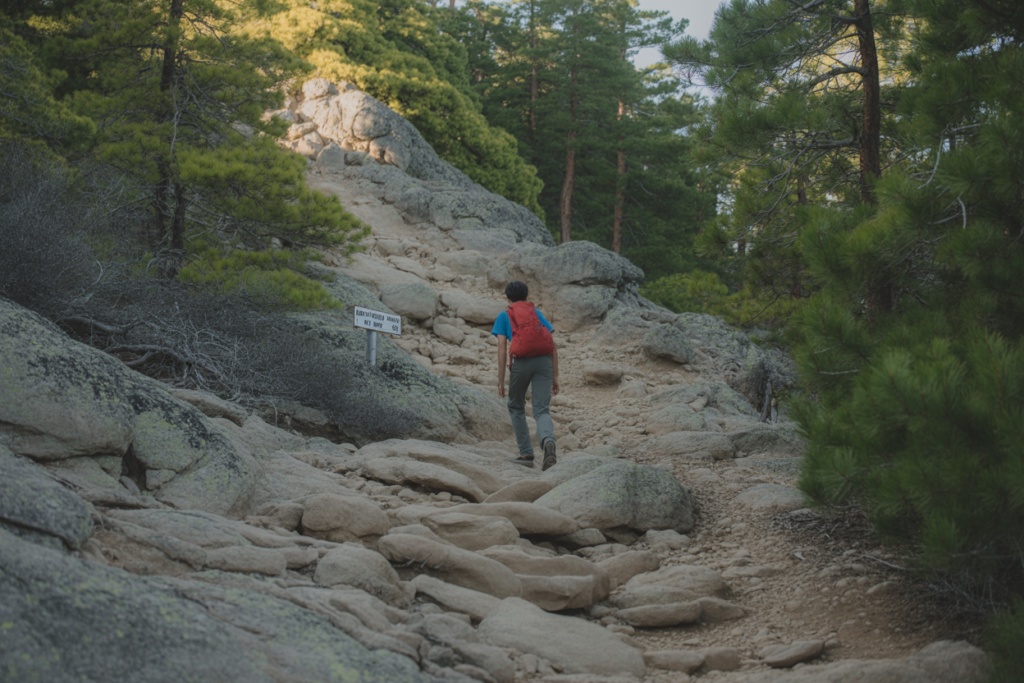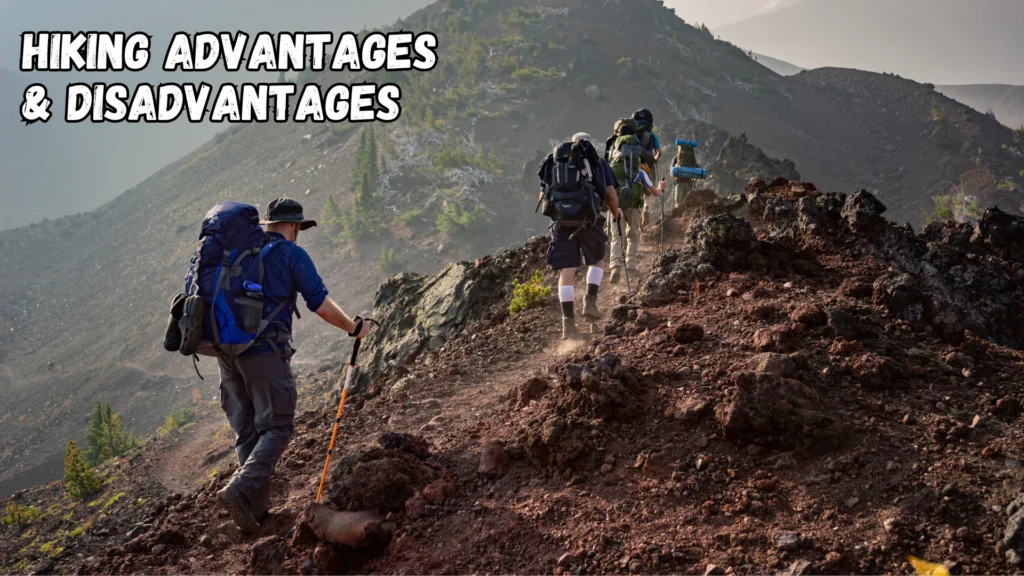A steep hiking trail is defined by its elevation gain. Typically, a trail is considered steep if it gains 500 to 1,000 feet per mile.
This level of incline can be challenging and requires good physical fitness. Hiking enthusiasts often seek out steep trails for the extra challenge and the rewarding views at the top. But what exactly makes a trail steep? Understanding the elevation gain per mile helps hikers prepare better and set realistic expectations.
Steep trails, with their significant elevation changes, demand more energy and stamina. Knowing this crucial detail can help you plan your hikes, choose the right gear, and ensure a safe and enjoyable experience. Let’s delve into what makes a hiking trail truly steep and how you can prepare for it.

Steep hiking brings adventure and challenge to outdoor enthusiasts. It involves trails with significant elevation changes. Knowing how many feet per mile is considered steep is crucial for planning and safety.
Importance Of Understanding Elevation
Elevation gain is a key factor in determining trail difficulty. Most hikers consider a trail with an elevation gain of 500 feet per mile steep. Understanding this helps hikers prepare physically and mentally.
Proper preparation can prevent fatigue and injuries. It allows hikers to pace themselves and carry necessary gear. Elevation knowledge also aids in estimating the time needed to complete a hike.
Common Misconceptions
Many believe that a higher elevation always means a tougher hike. This is not always true. Trail conditions, weather, and personal fitness levels also play a significant role.
Another common myth is that steep hikes are only for experts. While challenging, with proper preparation, even beginners can enjoy steep trails. Understanding and respecting your limits is key.
Knowing the elevation gain per mile helps in choosing the right trail. It ensures a safe and enjoyable hiking experience.
| Elevation Gain (feet per mile) | Trail Difficulty |
|---|---|
| 0-200 | Easy |
| 200-500 | Moderate |
| 500+ | Steep |
Defining Steepness In Hiking
Understanding the steepness of a hiking trail is essential for preparing your hike. Steep trails require more effort and can be challenging. They need careful planning and consideration.
There are various ways to measure trail steepness. One common metric is feet per mile. But there are other factors to consider too.
Feet Per Mile Measurement
The feet per mile measurement indicates how many feet you ascend per mile of hiking. This metric helps gauge the difficulty of a trail.
A trail is typically considered steep if it gains more than 500 feet per mile. For example:
| Trail Type | Feet Per Mile |
|---|---|
| Moderate | 250-500 feet |
| Steep | 500-1000 feet |
| Very Steep | 1000+ feet |
Other Metrics
Besides feet per mile, other metrics also help define steepness. These include:
- Grade Percentage: The incline of the trail expressed as a percentage.
- Elevation Gain: Total height gained during the hike.
- Trail Conditions: Rocky, muddy, or uneven trails can feel steeper.
Grade percentage is another way to understand trail steepness. A grade of 10% means a 10-foot rise for every 100 feet forward.
Elevation gain measures the total height climbed. For example, a trail gaining 2000 feet over 4 miles has an average of 500 feet per mile.
Trail conditions also affect perceived steepness. Rocky or muddy trails can make a moderate incline feel very steep.
Factors Affecting Steepness
Understanding the factors that affect the steepness of a hiking trail is crucial for both safety and enjoyment. Steepness can vary significantly depending on several elements. Let’s explore the main factors that can influence how steep a hike feels.
Terrain Type
The type of terrain plays a significant role in the steepness of a hike. Different terrains can present unique challenges:
- Rocky Paths: These can be very steep and require careful footing.
- Forest Trails: Often less steep but can be slippery due to leaves and roots.
- Gravel Roads: Can range from gentle inclines to sharp elevations.
- Mountain Trails: Typically the steepest, with varying degrees of difficulty.
Weather Conditions
Weather conditions can greatly affect the steepness of a hike. Here are some weather factors to consider:
- Rain: Makes trails slippery and can increase the difficulty.
- Snow: Adds an extra layer of challenge, making steep paths harder to navigate.
- Heat: Can make a steep hike feel even more strenuous.
- Wind: Strong winds can add resistance, making the climb tougher.
Understanding these factors can help you better prepare for your next hiking adventure. Always consider the terrain type and weather conditions before setting out on a steep hike.
Ideal Feet Per Mile For Different Skill Levels
Understanding the ideal feet per mile for hiking can enhance your experience. Different skill levels require different considerations. Knowing these can help you enjoy your hike more.
Beginner Hikers
For beginner hikers, a steep hike might be overwhelming. It’s best to start with a gentler incline. A climb of 200-400 feet per mile is suitable. This range allows beginners to build stamina. It also helps them get used to elevation changes without overexertion.
- 200-400 feet per mile
- Gradual elevation gain
- Focus on building stamina
Intermediate Hikers
Intermediate hikers can handle steeper trails. They have more experience and endurance. A range of 400-800 feet per mile is appropriate. This allows for a more challenging hike. It also helps in improving strength and endurance.
- 400-800 feet per mile
- Moderate elevation gain
- Improves strength and endurance
Advanced Hikers
Advanced hikers seek more challenging terrains. They are well-conditioned and experienced. A steep incline of 800-1200 feet per mile or more is ideal. This range offers a serious challenge and a rewarding experience. It is perfect for those who thrive on difficult hikes.
- 800-1200 feet per mile
- Significant elevation gain
- Offers a serious challenge
Popular Steep Hiking Trails
Exploring the world’s steep hiking trails offers thrilling adventures and breathtaking views. These trails challenge your physical limits and reward you with stunning scenery. Below, we highlight some popular steep hiking trails across different continents.
North American Trails
North America is home to some of the most famous steep hiking trails. These trails are known for their challenging climbs and scenic beauty.
- Mount Washington in New Hampshire: This trail gains 4,280 feet in just 4.2 miles. Known for its unpredictable weather, it’s a favorite among experienced hikers.
- Half Dome in California: Located in Yosemite National Park, this trail has an elevation gain of 4,800 feet over 8.5 miles. The final ascent involves using cables.
- Angel’s Landing in Utah: This Zion National Park trail has a 1,500 feet elevation gain in 2.5 miles. The narrow path and steep drop-offs make it a thrilling hike.
European Trails
Europe offers a variety of steep hiking trails, each with unique landscapes and challenges.
- Tour du Mont Blanc: This famous trail spans 110 miles and has significant elevation changes. It takes about 10 days to complete.
- Ben Nevis in Scotland: The highest peak in the UK, this trail has an elevation gain of 4,409 feet. It’s a popular destination for hikers.
- GR20 in Corsica: Known as one of the toughest trails in Europe, it covers 112 miles with steep ascents and descents. It typically takes 15 days to complete.
Asian Trails
Asia boasts some of the most challenging and beautiful hiking trails. These trails often include cultural and historical experiences.
- Mount Fuji in Japan: This iconic trail has an elevation gain of 4,500 feet. It’s a popular climb for both locals and tourists.
- Mount Kinabalu in Malaysia: This trail gains 7,400 feet over 5 miles. It’s known for its diverse flora and fauna.
- Everest Base Camp in Nepal: This trek involves significant elevation changes and reaches an altitude of 17,598 feet. It’s a bucket-list hike for many adventurers.
Preparing For A Steep Hike
Steep hikes are challenging. They demand more preparation than a regular hike. You need the right gear and physical conditioning. This guide helps you get ready for a steep hike.
Essential Gear
Having the right gear is crucial for a steep hike. Here is a list of essential items:
- Proper Footwear: Hiking boots with good grip and ankle support.
- Backpack: A sturdy backpack to carry your essentials.
- Water Bottle: Staying hydrated is key. Carry enough water.
- Clothing Layers: Weather can change. Wear layers to adjust easily.
- Navigation Tools: A map, compass, or GPS device.
- First Aid Kit: Be prepared for minor injuries.
- Snacks: High-energy snacks to keep your energy levels up.
Physical Conditioning
Physical conditioning is important for a steep hike. Here are some exercises to prepare:
- Cardio Training: Running, cycling, and swimming improve endurance.
- Strength Training: Focus on legs, core, and back muscles.
- Flexibility Exercises: Stretching and yoga enhance flexibility.
- Practice Hikes: Do practice hikes on varying terrains.
Here is a sample workout plan:
| Day | Exercise |
|---|---|
| Monday | Run 3 miles |
| Tuesday | Leg strength training |
| Wednesday | Yoga for flexibility |
| Thursday | Swim 1 mile |
| Friday | Core strength training |
| Saturday | Practice hike |
| Sunday | Rest |
Follow these tips. You will be well-prepared for your steep hike.
Safety Tips For Steep Hiking
Hiking steep trails can be thrilling but comes with risks. It’s vital to stay safe and prepared. Here are some essential tips to ensure your steep hiking adventure is both enjoyable and secure.
Navigational Tools
Always carry reliable navigational tools when hiking steep trails. A map and compass are essential. They help you stay on course and avoid getting lost. A GPS device is also handy. It’s more accurate and works in various weather conditions.
Smartphones with hiking apps can be useful. Ensure your phone is fully charged. Bring a portable charger for emergencies. Learn how to read topographic maps. They show elevation changes and steepness of trails.
| Tool | Purpose |
|---|---|
| Map and Compass | Basic navigation and orientation |
| GPS Device | Accurate location tracking |
| Smartphone with Hiking Apps | Additional navigation features |
Emergency Procedures
Being prepared for emergencies is crucial on steep hikes. Know the emergency numbers for the area. Carry a whistle to signal for help. Three short blasts indicate an emergency. A first aid kit is a must. Learn basic first aid skills. They can save lives.
Inform someone about your hiking plans. Include your expected return time. This helps rescuers locate you if needed. Pack extra food and water. Steep hikes are physically demanding. You might need more energy and hydration.
- Know emergency contact numbers
- Carry a whistle
- Pack a first aid kit
- Inform someone about your plans
- Bring extra food and water
Benefits Of Steep Hiking
Steep hiking is not just about conquering challenging trails. It also offers numerous benefits for both physical and mental well-being. Whether you’re an experienced hiker or just starting out, understanding these benefits can motivate you to tackle those steep inclines.
Physical Health
Steep hiking is an excellent way to improve cardiovascular health. The intense activity increases your heart rate, which strengthens your heart over time. It also helps to burn calories and shed extra pounds, making it a great option for weight loss.
Additionally, steep hiking builds muscle strength. Your legs, glutes, and core muscles get a robust workout as you navigate the incline. This can lead to better muscle tone and increased stamina.
Another benefit is improved bone density. Weight-bearing exercises like hiking can help to strengthen bones and reduce the risk of osteoporosis.
Mental Wellbeing
Steep hiking is not just good for the body; it also benefits the mind. The challenging nature of steep hikes requires focus and determination. This can help to improve mental resilience.
Being in nature has been shown to reduce stress and anxiety. The fresh air and beautiful scenery can enhance your mood and provide a sense of peace.
Steep hiking also offers a sense of accomplishment. Reaching the top of a tough trail can boost your self-confidence and provide a deep sense of satisfaction.
| Benefits | Description |
|---|---|
| Cardiovascular Health | Strengthens heart and improves overall cardiovascular function. |
| Muscle Strength | Builds muscle in legs, glutes, and core. |
| Bone Density | Improves bone strength and reduces osteoporosis risk. |
| Mental Resilience | Enhances focus, determination, and stress management. |
| Mood | Reduces anxiety and improves overall mood. |
| Self-Confidence | Boosts self-esteem through the sense of accomplishment. |
Understanding how many feet per mile is considered steep hiking helps you prepare better. A steep trail requires more energy and caution. Trails with over 500 feet per mile are challenging. Always check the trail elevation before hiking. This ensures safety and enjoyment.
Proper preparation makes your hike more enjoyable. Equip yourself with the right gear. Hydrate well and pace yourself. Happy hiking!
FAQs:
What Is Considered A Steep Hiking Trail?
A steep hiking trail typically has an elevation gain of 500 feet per mile or more. This makes it challenging.
How Many Feet Per Mile Is Steep?
A steep trail usually gains 500 feet per mile. This indicates a challenging hike.
Is 700 Feet Per Mile Steep?
Yes, 700 feet per mile is considered very steep. It requires good fitness.
What Elevation Gain Is Moderate?
Moderate hikes have an elevation gain of 250 to 500 feet per mile. They are less challenging.



